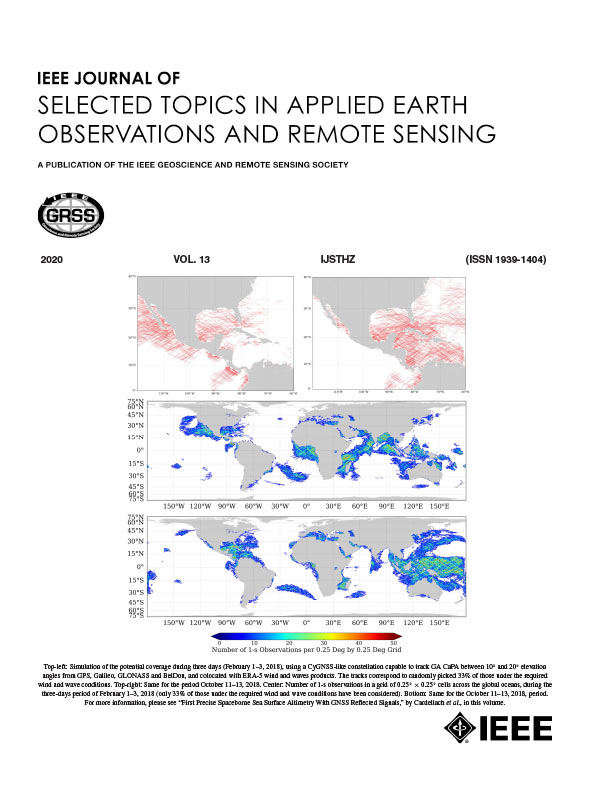Spectral–Spatial Feature Extraction Network With SSM–CNN for Hyperspectral–Multispectral Image Collaborative Classification
IF 4.7
2区 地球科学
Q1 ENGINEERING, ELECTRICAL & ELECTRONIC
IEEE Journal of Selected Topics in Applied Earth Observations and Remote Sensing
Pub Date : 2024-09-19
DOI:10.1109/JSTARS.2024.3464681
引用次数: 0
Abstract
Multisource remote sensing (RS) image classification is a significant research area in Earth observation, aiming to achieve more comprehensive and accurate classification of land cover by integrating data from different sensors. Due to differences in imaging mechanisms and information imbalance between multisource data, multisource RS image classification faces two major challenges as follows. 1) Synergistically capturing features from different modalities to fully exploit complementary information. 2) Adaptively fusing multisource features to overcome the imbalance between modalities and avoid redundant information. This article proposes a spectral–spatial feature extraction network with SSM–CNN (SSFNet) for the collaborative classification of hyperspectral images (HSI) and multispectral images (MSI). Specifically, SSFNet captures long-range spectral correlations in HSI through a bidirectional state–space model (SSM) and learns local correlations between adjacent channels through spectral grouping, achieving global–local spectral information mining in HSI. Simultaneously, joint spatial feature extraction for HSI and MSI data is performed using embedded weight-shared residual feature extractor based on convolutional neural network. This process involves adaptively identifying the importance of features through privatized factors in batch normalization and accurately replacing redundant features. In addition, a spatial attention module is used to further enhance spatial feature representation. Finally, to better accommodate feature distributions and enhance classification outcomes, the extracted spectral–spatial features are combined using weighted fusion, allowing for dynamic integration. Experimental results on two datasets demonstrate that the proposed SSFNet significantly outperforms other competing methods.用于高光谱-多光谱图像协作分类的光谱-空间特征提取网络与 SSM-CNN
多源遥感(RS)影像分类是地球观测领域的一个重要研究领域,旨在通过整合不同传感器的数据,实现更全面、更准确的土地覆被分类。由于成像机制的差异和多源数据之间的信息不平衡,多源遥感影像分类面临以下两大挑战。1) 协同捕捉不同模态的特征,充分利用互补信息。2) 自适应地融合多源特征,克服模态间的不平衡,避免冗余信息。本文提出了一种带有 SSM-CNN 的光谱空间特征提取网络(SSFNet),用于高光谱图像(HSI)和多光谱图像(MSI)的协同分类。具体来说,SSFNet 通过双向状态空间模型(SSM)捕捉 HSI 中的长距离光谱相关性,并通过光谱分组学习相邻通道之间的局部相关性,从而实现 HSI 中的全局-局部光谱信息挖掘。同时,利用基于卷积神经网络的嵌入式权重共享残差特征提取器,对 HSI 和 MSI 数据进行联合空间特征提取。这一过程包括通过批量归一化中的私有化因子自适应地识别特征的重要性,并准确替换冗余特征。此外,还使用了空间关注模块来进一步增强空间特征表示。最后,为了更好地适应特征分布并提高分类结果,利用加权融合技术将提取的光谱-空间特征结合起来,从而实现动态整合。在两个数据集上的实验结果表明,所提出的 SSFNet 明显优于其他竞争方法。
本文章由计算机程序翻译,如有差异,请以英文原文为准。
求助全文
约1分钟内获得全文
求助全文
来源期刊
CiteScore
9.30
自引率
10.90%
发文量
563
审稿时长
4.7 months
期刊介绍:
The IEEE Journal of Selected Topics in Applied Earth Observations and Remote Sensing addresses the growing field of applications in Earth observations and remote sensing, and also provides a venue for the rapidly expanding special issues that are being sponsored by the IEEE Geosciences and Remote Sensing Society. The journal draws upon the experience of the highly successful “IEEE Transactions on Geoscience and Remote Sensing” and provide a complementary medium for the wide range of topics in applied earth observations. The ‘Applications’ areas encompasses the societal benefit areas of the Global Earth Observations Systems of Systems (GEOSS) program. Through deliberations over two years, ministers from 50 countries agreed to identify nine areas where Earth observation could positively impact the quality of life and health of their respective countries. Some of these are areas not traditionally addressed in the IEEE context. These include biodiversity, health and climate. Yet it is the skill sets of IEEE members, in areas such as observations, communications, computers, signal processing, standards and ocean engineering, that form the technical underpinnings of GEOSS. Thus, the Journal attracts a broad range of interests that serves both present members in new ways and expands the IEEE visibility into new areas.

 求助内容:
求助内容: 应助结果提醒方式:
应助结果提醒方式:


